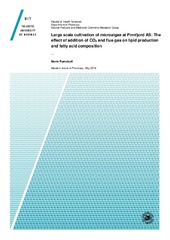| dc.description.abstract | Background: This master’s thesis was a part of a project involving mass cultivation of microalgae at the smelting plant Finnfjord AS. Microalgae are primary producers of the important omega-3 long-chain polyunsaturated fatty acids EPA and DHA. At Finnfjord, the algae use CO2 from the flue gas for their production of lipid and protein rich biomass. The algal biomass can potentially function well as fish feed for the aquaculture industry. In this thesis, the main goal was to investigate how the addition of flue gas affects the lipid content and fatty acid composition of the algae.
Method: Two algal species were included in the project. Porosira glacialis was cultivated with and without addition of CO2 and flue gas (from Finnfjord), and Chaetoceros furcellatus was cultivated with and without addition of CO2. From freeze-dried algal biomass, the lipids were extracted. Fatty acids were isolated from larger lipids and derivatized to fatty acid methyl esters (FAMEs) by methylation/transesterification, for quantitative analysis, and further derivatized to picolinyl derivatives for structure elucidation. To analyze the fatty acid derivatives, GC/MS with EI and full scan mode was applied. For identifying molecular ions of FAMEs, a method using GC/MS with CI and SIR was developed. In addition, GC/MS/MS with a product ions scan approach was also tested.
Results: The content of polyunsaturated fatty acids, including EPA, were generally high in all the algae samples, and the omega-3/omega-6 ratio was also particularly high. The addition of CO2 and flue gas had a small impact on lipid content and fatty acid composition of the algae. Most importantly, the proportion of unsaturated fatty acids was not reduced by the addition of flue gas, and the lipid content was only slightly reduced. The double bond positions of all the fatty acids in the algae, except 18:3, were determined. GC/MS with CI and SIR appeared to be useful for determination of molecular ions of FAMEs. The method provided better sensitivity and selectivity compared to EI and full scan mode. GC/MS/MS with a product ion scan approach was, on the contrary, unsuccessful for analysis of both FAMEs and picolinyl derivatives.
Conclusion: Based on the lipid content and fatty acid profile of the algae, the use of algal biomass as fish feed for the aquaculture industry seems promising. | en_US |


 English
English norsk
norsk
